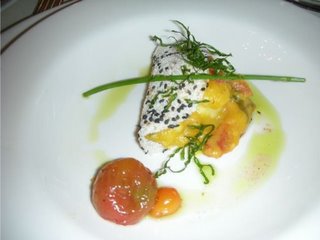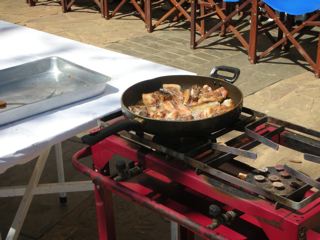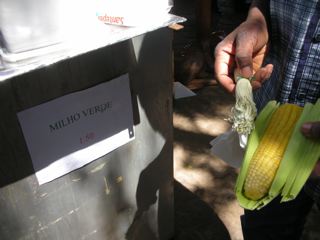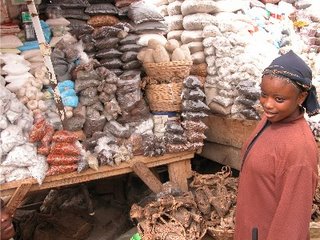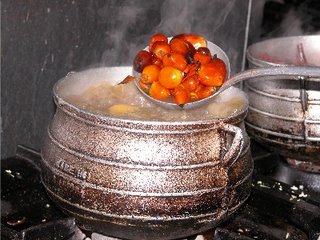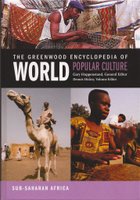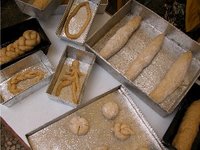
I've probably had more interest expressed in finding a recipe for Ghana's tea bread than any other recipe.
In 2002 in Ghana I asked the owner of PamFran Co., a bakery in Accra, to teach me to make Ghana-style sugar bread and tea bread. She came to Flair Catering where I was staying, and demonstrated quantities and techniques. After returning to Pennsylvania, my first attempt to recreate her tea bread failed miserably: mine was hard as a rock. I returned to Ghana 2 years later, and went back to Mrs. Spendlove, Pamela Ayele Attipoe, to be shown again. This time I went to her bakery, and realized her commercial mixers and rollers also affect the texture of her bread. I'm still trying to perfect my recipe. I thought I'd share where I am so far.
One difference between Ghana and Pennsylvania tea bread is the gluten content in the flour: Ghana's has more gluten. In Accra we mixed flour from Takoradi and Irani mills to average the hardness (Ghana does not grow its own wheat, but imports it and mills it locally. I've read that around 90% comes from the U.S. I think, but am not sure, that it imports mostly hard red winter wheat). This time I used bread flour, which may still not be as hard.
Anyhow, I've combined the 2 lessons in Accra with another, older recipe from the 1953 edition of
Gold Coast Nutrition and Cookery. The 1953 recipe uses palm wine, but I substituted yeast and a little extra water. However, I noticed that Marian Shardow has a recipe for palm wine bread in her
A Taste of Hospitality and says you can substitute white wine for palm wine. I'll try that next. I'm still having some trouble getting the sugar and salt in the right proportions, and my dough is rising faster than the 8 hours it takes in Ghana, but I'll keep working on it. In the meantime, any of you who'd like to take a crack at it and let me know your versions/results, here's where I've gotten to so far with my recipe development (I'm using U.S. measurements):
2 lb. 3 oz. of bread flour (about 7 1/2 cups)
2 oz. of sugar (this needs increasing some, I think)
1.5 t yeast (or 1 rounded teaspoon; I may try 1 t next time)
2 t ground nutmeg (reduce to 1 1/2 t?)
2 t salt (down from 1 T)
4 oz margarine
about 2 cups warm water
I weighed, then sifted the flour, added the sugar, yeast, nutmeg and salt, and mixed in the water gradually, first with a spoon, then my hands. Finally, I continued mixing in the margarine (not butter) with my hands.
I kneaded the dough on a floured surface for about 10 minutes until it was elastic and smooth (it's a stiffer dough than a normal white or whole wheat dough), and turned it into a greased bowl, covered it with a dishtowel and set it in a warm oven to rest and ferment for about half an hour. Then I punched the dough down, divided it in half and stretched each half out and formed each into one-pound loaves to put inside lightly greased aluminum bread pans I brought from Ghana and let them rise (proof) inside my warm oven with a bowl of water below them to keep them from drying out (I also covered them with the dish towel). Instead of the 8 hours I was hoping for, after 4 hours they were at the top of the pans and needed to be baked. I put them in a hot oven (425 degrees F) for about 15 minutes, then turned the heat down to 375 for another 30 minutes. Next time I'll just cook them at 375 degrees for the full 45 minutes or so (my crust browned too quickly).
Today I halved the recipe and just added everything into my bread machine on the dough setting and mixed it, then turned it into a lightly greased bowl to let it rise. It's still rising. I'll wait 7 or 8 hours before I punch it down and make the loaf, then let it rise for about 30 minutes and bake it at 375 degrees F for about 45 minutes.
Family taste test: For the first version listed above my husband said there was an elusive flavoring he seemed to think his mother's tea bread used to have (someone suggested it might be mace?). Teenager Sam said he thought mine had too much nutmeg and the texture was different, plus the crust was too tough. Sam and I thought there was too much salt, but my husband disagreed. I'll let you know how the recipe testing process goes as we keep working on this. Please do share your insights.

Labels: Ghana bread, Ghana tea bread, Osseo-Asare
